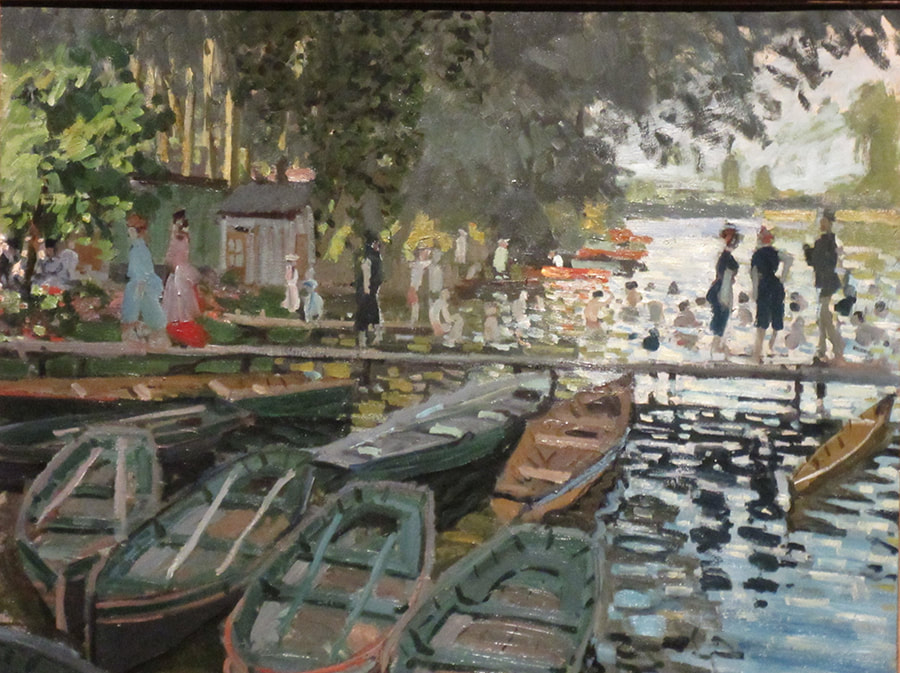|
This week, I wanted to talk about Claude Moent's “Bathers at La Grenouillere.” which is in the collection of the National Gallery in London.
Claude Monet was born in Paris in 1840. His father was a small businessman and the family moved to Le Harve about five years later so that his father could join a wholesale grocery firm that was owned by family members. Thus, Monet came from a middle class background. From an early age, Claude displayed a talent for drawing. Over time, he developed a reputation in Le Harve for his comic drawings and caricatures and was able to derive income from the sale of such works. With such a beginning, one might well expect that Monet would have developed into a portrait painter. However, one day when he went out to watch Eugene Boudin work on a landscape, he realized that landscapes were what he wanted to paint. “I had seen what painting could be, simply by the example of this painter working with such independence at the art he loved. My destiny as a painter was decided.” Friends and family recognized that Monet had talent. However, they were unanimous in saying that he needed to refine that talent by studying in the studio of an established artist. At that time, the most respected artists produced highly polished works with extensive modeling and glazing. The apex of the art world was history painting in which figures were depicted in scenes that told a story. Every artist's ambition was to have a work shown at the prestigious Salon in Paris. Monet was quite independent and bridled against such suggestions. Nonetheless, he went to Paris to study first at the Academie Suisse and later at the studio of Charles Gleyre, an established conventional artist. He did not like the conventional approach to the study of art. Although he often completed works in the studio, Monet preferred to work outdoors, painting directly from nature. However, his time in Gleyre's studio was not wasted because there he met Frederic Bazille and Pierre Auguste Renoir, who would be his compatriots in the Impressionist movement. Despite his dislike of conventional painting, Monet prepared and submitted several works to the Salon during this period. Most were genre paintings depicting contemporary people outdoors. In some respects, these works were reminiscent of Edourard Manet's work, Manet being something of a hero to Monet and his friends. They were more polished and the colors more subdued than Monet's later works. Nonetheless, the Salon rejected Monet's submissions. In the eyes of the juries, the works were unfinished and they failed to tell a story. During these years, Monet was able to sell some paintings but he often spent more than he earned.. Subsidies, first from his aunt and later by Bazille enabled him to continue on as an artist. In 1869, Monet moved with his mistress and young son to a cottage in Saint-Michel near Paris. Renoir was living with his parents nearby and so the two painters would often go out and paint the same subjects together. One of the places they were was La Grenouillere (the Frog Pond) a floating restaurant on the Seine at Bougival. The cafe was attached to a small island and to the riverbank by pontoons. There was a place to moor boats and a place for swimming. It was a very popular venue for socializing and summer fun. Indeed, it achieved such a reputation that Emperor Napoleon III and Empress Eugene came to have a look. Bathers at La Grenouiller is one of a series of studies Monet made in preparation for a larger more polished work that Monet submitted to the Salon. The larger work was rejected and later lost during World War II. What makes Bathers particularly interesting is that it is a forerunner of the style Monet would use in his later works when he was no longer working with the idea of submitting paintings to the Salon. The artist used color rather than lines to create the image. Figures, water, foliage are all described with a few bold brush strokes. The composition has a snapshot quality - - a scene of everyday life. Monet does not comment on the scene. He does not condemn it as people having frivolous fun nor does he praise it as welcome relief for the everyday worker. He just presents the scene and the viewer can make up his or her own mind. The picture can be dived into four quadrants with the pier dividing the picture horizontally and a vertical line right of center descending from the trees past the boats. Each section is a separate picture. However, the S curve of the river brings the composition together. A painting such as the Bathers would not have been possible only a few years before. The invention of the paint tube in the 1840s enabled Monet to easily transport his palette to the scene. Similarly, the invention of the metal ferrule made flat brushes possible. Such brushes enable Monet to work quickly and their use is documented by the flat brush strokes in this painting. The lesson here being that artists should not be afraid of employing new technology. |
AuthorRich Wagner is a writer, photographer and artist. Archives
November 2018
Categories
All
|

 RSS Feed
RSS Feed